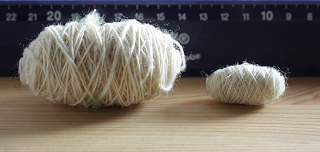In preparation for the spinning experiment on the Textilforum, I need to figure out how much fibres to calculate for each participant. And to get a first impression, I spun with the carded and combed wool I have at hand - one hour in my normal thickness, and another hour as thick as I could manage.
Now I'm one of those people who have a very limited range of thickness when spinning. And (unfortunately for this purpose) it is rather on the fine side. So I ended up with two very different-sized balls of yarn; I wound them off today and weighed them with my letter scales.
The "Thick Yarn" weighs in at about 8 g for one hour's spinning time. It is pretty uneven, in spite of my trying oh-so-hard to spin a decently smooth and even yarn. Thick stuff is just not for me. Here you see the sorry results of my thick-spinning:

Beside the huge (haha), bulky and uneven ball of thick yarn, you can see what I spun as my normal thin yarn. The weight? Somewhere between one and two grammes. Both yarns spun with the same wool on the same spindle (which was about double the weight of the reference whorl for the experiment, and fitted with a rather heavy wooden spindle stick). When wound onto a ruler, the thick wool gives about 20 threads per inch, the thin one about 12 threads per quarter-inch.
So now I've outed myself as a thin-spinning freak, can any spinners of thick yarn out there give me a rough estimate of how much fiber in grammes they hand-spindle away in one hour? Just to check against my calculations? I'd be very grateful...
Now I'm one of those people who have a very limited range of thickness when spinning. And (unfortunately for this purpose) it is rather on the fine side. So I ended up with two very different-sized balls of yarn; I wound them off today and weighed them with my letter scales.
The "Thick Yarn" weighs in at about 8 g for one hour's spinning time. It is pretty uneven, in spite of my trying oh-so-hard to spin a decently smooth and even yarn. Thick stuff is just not for me. Here you see the sorry results of my thick-spinning:

Beside the huge (haha), bulky and uneven ball of thick yarn, you can see what I spun as my normal thin yarn. The weight? Somewhere between one and two grammes. Both yarns spun with the same wool on the same spindle (which was about double the weight of the reference whorl for the experiment, and fitted with a rather heavy wooden spindle stick). When wound onto a ruler, the thick wool gives about 20 threads per inch, the thin one about 12 threads per quarter-inch.
So now I've outed myself as a thin-spinning freak, can any spinners of thick yarn out there give me a rough estimate of how much fiber in grammes they hand-spindle away in one hour? Just to check against my calculations? I'd be very grateful...



